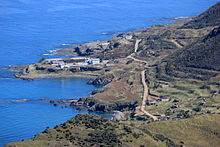Erenköy / Kokkina
|
Erenköy Κόκκινα / Kokkina |
||
|---|---|---|
|
|
||
| Basic data | ||
| State : |
|
|
| District : |
|
|
| Geographic coordinates : | 35 ° 11 ′ N , 32 ° 37 ′ E | |
| Residents : | 0 (2016) | |
Erenköy or Kokkina ( Turkish formerly Koççina, Greek Κόκκινα ) is a place in the Tylliria region (Turkish Dillirga) in the northwest of the Mediterranean island of Cyprus , which is also an exclave of the Lefke district of the Turkish Republic of Northern Cyprus , which was founded in 1983.
Since the 19th century at the latest, the population consisted almost exclusively of Cypriot Turks who had to relocate to other parts of Northern Cyprus as a result of the Cyprus conflict . Today the place serves purely military purposes. Of United Nations peacekeeping , the United Nations Peacekeeping Force in Cyprus (UNFICYP) oversaw UN buffer zone is on three sides of the end controlled by the TRNC territory.
history
Kokkina or Koççina means “red” in Greek. Originally the place where today's Erenköy is located was called Ayia Eleni. A map from 1885 shows only a church and a few residential buildings. Apparently nobody lived there until 1911. After Kutlu Adalı, Turkish Cypriots from Kokkina / Koççina were induced to settle this place in 1936. They came from a place also called Kokkina, which was near Alevga on Karga Hill. During the resettlement, the new settlers named the village Kokkina, but this name was renamed Erenköy (in German holy place ) in 1958 .
In 1964, fighting between Greek Cypriot and Turkish Cypriot villages took place in the Tylliria region in the course of the Cyprus conflict . In the course of these conflicts, the area around Erenköy was surrounded by Greek army units and the Cypriot National Guard and sealed off from the outside world. The population was displaced and had to seek shelter at sea, many houses in the village were destroyed. Over 100 Cypriots were killed and more than 200 injured in the fighting. Before that, Rauf Denktaş and 500 Turkish students had smuggled weapons into the town at the end of 1963.
The Turkish defenders held their positions until August 8, 1964, when Turkey intervened militarily in the conflict. Their air force bombed targets around Erenköy and also used napalm against Greek Cypriot troops. A total of 50 people were killed and 125 injured. Civilians were also killed in this attack. Finally, the United Nations Security Council ordered a ceasefire; this came into force on August 9, 1964 and was monitored by United Nations peacekeeping forces , the United Nations Peacekeeping Force in Cyprus (UNFICYP) .
Erenköy was subject to a blockade imposed by the Cypriot government from August 1964 to November 1967 and was separated from Turkish territory by the neighboring town of Pyrgos . The restrictions on the introduction of “non-strategic goods” were lifted in June 1965. Richard Patrick noticed in 1971 that 677 Turkish Cypriots lived in the place. In November 1976, all residents were relocated to Yialousa on the Karpas , which the government renamed Yeni Erenköy (New Erenköy). Since then, Erenköy has only been inhabited by military personnel and has been cut off from its immediate surroundings.
Web links
- Kokkina , table on population development since 1891 and further information
Remarks
- ↑ Douglas Brinkley: The Cyprus Question: Dean Acheson as Mediator , in: Journal of the Hellenic Diaspora 15,3-4 (1988) 5-36, here: p. 14.
- ^ Middle East Research and Information Project
- ↑ Mensur Akgün, Ayla Gürel, Mete Hatay, Sylvia Tiryaki: Quo vadis Cyprus? , thesis working paper, April 2005, o. S. ( online , PDF)
- ↑ hri.org , Cyprus Mail 2001.
- ↑ time.com



